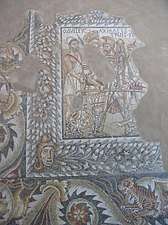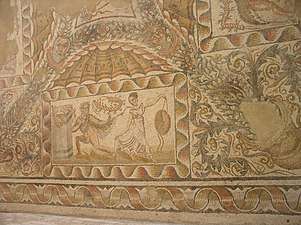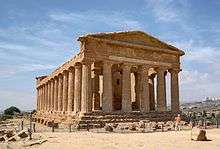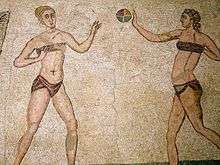Villa Romana del Tellaro
The Villa Romana del Tellaro is a Roman villa dating from the late Roman Empire on Sicily in southern Italy.[1] It is located south of Noto in the province of Syracuse.
Entrance of the site | |
 Shown within Italy | |
| Location | Noto, Province of Syracuse, Sicily, Italy |
|---|---|
| Coordinates | 36°50′07″N 15°04′43″E |
| Type | Dwelling |
| History | |
| Periods | Roman Imperial |
| Cultures | Roman |
| Site notes | |
| Condition | Restored |
| Ownership | Public |
| Management | Soprintendenza BB.CC.AA. di Siracusa |
| Public access | Yes |
| Website | www |
History and description
The remains of the villa were found in 1971 in a fertile agricultural area, on a low elevation near the Tellaro river. The site was located on a farm dating from the 17th to the 19th century.
The central building was constructed around a large peristyle. The section of the porch on the north side had a floor which was decorated with mosaics. They show laurel wreathes forming circles and octagons with geometric and floral motifs. They border two other rooms that retain figurative mosaics.
In the first of these rooms a very damaged mosaic contains a panel with scenes of the ransom of the body of Hector. In this scene Odysseus, Achilles and Diomedes, identified by inscriptions in Ancient Greek, are weighing the body of the hero. The figure of Priam is lost, but the legs of Hector's body can be seen partially on the right side of the scales. The gold of the ransom is visible on the left side. This event was not mentioned in the Iliad by Homer and is probably derived from a tragedy of Aeschylus. The mosaic floor in the second room shows a hunting scene with a banquet in the open air among the trees. The female figure in the scene is the personification of Africa.
The scenes on the mosaic found in the second room are reminiscent of the mosaics in the Villa Romana del Casale near Piazza Armerina. However, this mosaic has more stylized figures and two-dimensional, uncertain proportions, making the effect very different. The mosaics were probably the work of craftsmen from North Africa. Based on numismatic evidence, they were made in the second half of the fourth century CE.
The villa today
The villa has seen renewed interest in recent years, mainly due to a series of reconstruction projects and redevelopment of the site. On 15 March 15, 2008, over thirty years after the excavations, it was finally inaugurated and made accessible to the public.
Behind the villa lie vineyards, where the traditional grapes of the region are still grown. These include Nero d'Avola, Muscat and Albanello Bianco which are increasingly difficult to find today.
Further reading
- Dunbabin, Katherine M. D. (2001). Mosaics of the Greek and Roman World. New York: Cambridge University Press. pp. 142–143. ISBN 9780521002301.
- Sfameni, Carla (2004). "Residential Villas in Late Antique Italiy: Continuity and Change". In Bowden, William; Lavan, Luke; Machado, Carlos (eds.). Recent Research on the Late Antique Countryside. Late Antique Archaeology. 2. Leiden: Brill. pp. 335–375. ISBN 9789004136076.
- Voza, Giuseppe (1982). "Le ville romane del Tellaro e di Patti in Sicilia e il problema dei rapporti con l'Africa". 150-Jahr-Feier Deutsches Archäologisches Institut Rom: Ansprachen und Vorträge, 4–7 Dezember 1979. Mitteilungen des Deutschen Archäologischen Instituts - Römische Abteilung (in Italian). 25. Mainz: Philipp von Zabern. pp. 202–209. ISBN 3805305583.
- Voza, Giuseppe (2003). I mosaici del Tellaro, lusso e cultura nel sud est Sicilia (in Italian). Erre Produzioni. ISBN 9788887909067.
External links
| Wikimedia Commons has media related to Villa del Tellaro (Noto). |


.jpg)
.jpg)

